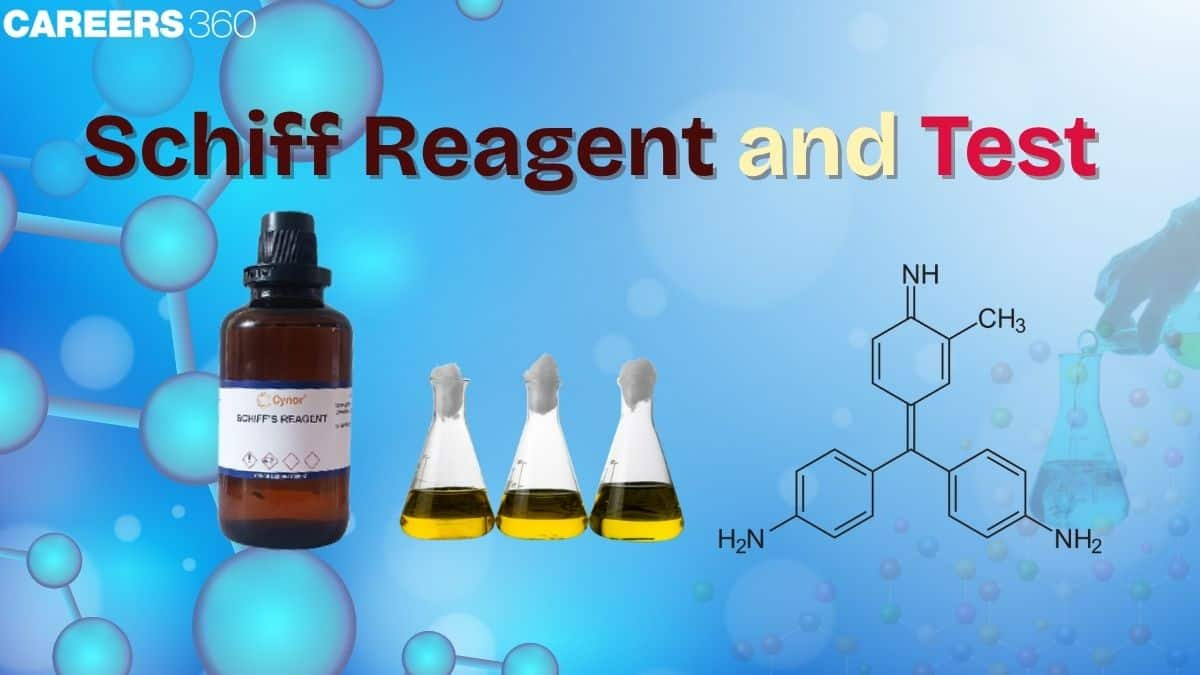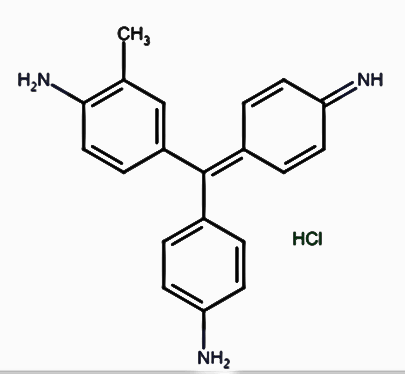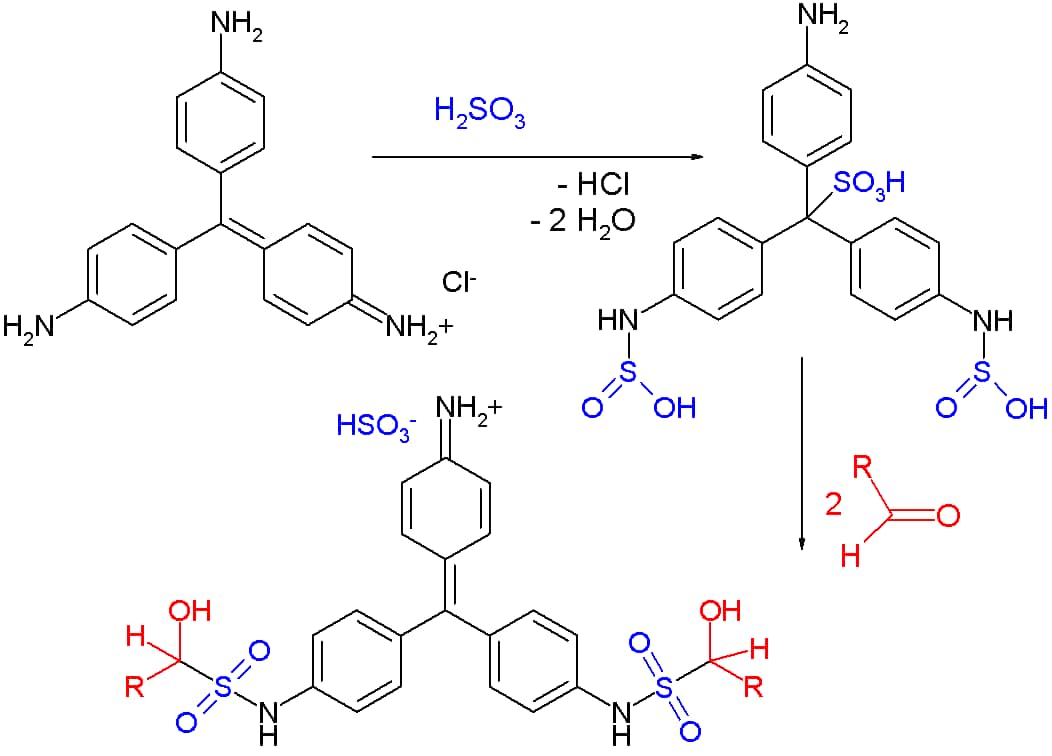Schiff Reagent and Test - Composition, Preparation, Structure, Reaction, FAQs
Ever think about how chemists detect unknown compounds or the presence of certain molecules in solutions or medicines with the help of just a few drops? It seems difficult, but it is not, we have various reagents that help to detect the presence of certain groups or molecules in a solution. Out of all these reagents, we are going to discuss Schiff’s reagent. It is used to detect the presence of an aldehyde group in organic compounds.
This Story also Contains
- What Is The Schiff’s Test?
- Schiff's Reagent
- Composition Of Schiff's Reagent
- Schiff’s's Reagent Preparation
- Rosaniline Structure
- Schiff’s Test Reaction
- Some Solved Examples

Schiff’s reagent was invented by Hugo Schiff’s, a German chemist. The Schiff’s test is performed with the help of Schiff’s reagent. It is a colourless or pale solution of fuchsin dye treated with sulphurous acid. When Schiff's reagent comes into contact with an aldehyde, it changes its colour from colourless to pink. This test is simple yet widely applicable in various industries like food testing, forensic science, industrial quality control, etc. In this article, we will read about what is Schiff's reagent and test questions related to Schiff’s reagent and test. Scroll down to know more.
What Is The Schiff’s Test?
This qualitative test for aldehydes (used to check the presence of aldehydes) is performed using Schiff’s reagent. The sample that needs to be examined is combined with Schiff’s reagent. If aldehyde is present, a characteristic magenta-pink color is obtained.
Any compound with an aldehydic -CHO group will show a positive Schiff’s test. Example: Human skin is stained due to the presence of aldehydes in the tissues of the skin. Although sometimes aliphatic ketones might show positive results, the overall process for colorization is slow and takes time for the pink color to emerge. Aromatic aldehyde reacts similarly to aliphatic ketones with Schiff’s reagent, but aromatic ketones do not produce color in the presence of Schiff’s reagent.
Schiff's Reagent
The name of Schiff’s reagent is Fuchsine or basic fuchsine. The IUPAC name of Schiff's reagent is 4-[((4-Dimethylaminophenyl)imino)methyl]phenol. Schiff’s reagent is a product of the formulation of certain dyes, such as fuchsin and sodium bisulfate, which chemically react with aldehydes to form a bright pink product. Schiff’s reagent is sometimes referred to as leucofuchsin. The term ‘leuco’ means white or absence of color, which is termed due to a very pale yellow color or nearly colorless solution. The fuchsin dye is decolorized by the addition of sulfurous acid (or its conjugate base bisulfate) due to which it is also referred to as fuchsin-sulfurous acid. Fuchsin dye is also known as rosaniline hydrochloride and is marked by its magenta color.
Schiff's reagent contains:
- Rosaniline hydrochloride (fuchsin)
- Sulfur dioxide (SO2)
- Water (as solvent)
$\mathrm{SO}_2$ converts the intense pink dye into a colorless derivative.
Composition Of Schiff's Reagent
The Schiff’s reagent is prepared by using fuchsin (<1%) dye in water (>98%) combined with sodium bisulfite (<1%) dissolved in a solution of hydrochloric acid (<1%). The solution is shaken at intervals, followed by decolorization with charcoal. The mixture is then filtered. Fresh activated charcoal must be used to ensure the formation of a perfectly colorless solution. If the solution is not colorless, the solution is refiltered.
Schiff’s's Reagent Preparation
The precise steps of preparation are stated below:
- In 900 mL of boiling water, dissolve 5g basic fuchsin.
- Cool down the solution until it reaches around 50°C.
- Slowly add 100 mL of 1M HCl to the dilute solution of fuchsin.
- Again, cool down the solution to 25°C.
- To the cooled solution, add 10g K2S2O5.
- Shake the above solution for 3 minutes and leave the solution mixture to incubate in a dark room for 24 hours.
- After incubation and resting, add 5g of fine activated charcoal to the reaction mixture.
- Shake the solution for 3 minutes and filter.
- A crystal clear solution must be obtained, or else refiltration and retreatment must be done.
- Store the prepared solution at 4°C in a bottle covered with foil. Schiff’s reagent precipitates a white crystalline substance if not stored properly. Thus, fresh batches at intervals of 2-3 weeks must be prepared to ensure accurate results.
| Related topics link, |
Rosaniline Structure

Rosaniline hydrochloride or fuchsin is a pinkish magenta color dye used in Schiff’s reagent to detect the presence of aldehydes. In Schiff’s reagent, it is decolorized by sulfurous acid to form a colorless solution.
Schiff’s Reagent formula: Schiff’s reagent’s molecular formula is C20H19N3·HCl.
Schiff’s Test Reaction

The reaction is initiated when rosaniline hydrochloride or fuchsin, with a characteristic magenta color, is decolorized by adding sulfurous acid H2SO3. The decolorization is due to the distortion of the chromophore (chromophore is a term used to define atoms or groups of atoms that are responsible for the presence of color in a compound) by the addition of the sulphonic acid -SO3H group to the central carbon, resulting in loss of the quinoid ring.
This is known as Schiff’s reagent. When this new sulphonic acid substituted compound or Schiff’s reagent reacts with two molecules of aldehydes, condensation takes place which reforms the chromophore and restores the quinoid ring. Thus, a pink-magenta color is reproduced, indicating the presence of aldehydes.
Some Solved Examples
Question.1 What is Schiff's reagent primarily used to detect?
a) Alcohols
b) Aldehydes
c) Ketones
d) Carboxylic acids
Solution:
Schiff’s test is a chemical test used to check for the presence of aldehydes in a given analyte.
Hence , the correct answer is option b) Aldehydes
Question.2 What is the composition of Schiff’s reagent?
a) Fuchsine + Sulfuric acid
b) Fuchsine + Sulfur dioxide
c) Fuchsine + Sodium hydroxide
d) Fuchsine + Acetic acid
Solution: Schiff's reagent is a solution used primarily for detecting aldehydes. It is composed of the Fuchsine (or Basic Fuchsine) and Sulfur Dioxide (SO₂)
Hence, the correct answer is option b) Fuchsine + Sulfur dioxide
Question 3: Acetaldehyde, Acetone, acetic acid and methyl ketone (or methyl acetate) are given. With which of these does Schiff’s reagent give a pink (magenta) colour?
A. Acetaldehyde
B. Acetone
C. Acetic acid
D. Methyl acetone
Solution:
Schiff’s reagent is a qualitative test for aldehydes; on reaction with an aldehyde, the originally decolourized reagent turns pink / magenta. Acetaldehyde is an aldehyde, so gives positive test. The ketones (acetone, methyl ketone) and carboxylic-acid derivative (acetic acid or ester) do not give the pink colour.
Hence, the correct answer is option (A)
Question 4: The reagent with which both acetaldehyde and acetone react easily is
(a) Tollens' reagent
(b) Schiff’s reagent
(c) Grignard reagent
(d) Fehling's reagent
Solution:
Except for the Grignard reagent, the other listed reagents (Tollens, Schiff’s, Fehling) typically react with aldehydes, not with ketones like acetone. Schiff’s reagent does not generally react with acetone — hence options with only aldehyde reactivity are incorrect if both acetaldehyde and acetone must react.
Hence, the correct answer is option (c)
Practice more questions with the link given below:
| Methods of Preparation of Aldehydes and Ketones Practice Questions and MCQ |
| Reaction of Aldehydes and Ketones practice questions and MCQ |
Also Read:
Frequently Asked Questions (FAQs)
Schiff reagent is a chemical solution that is used to detect the presence of an aldehyde group in organic compounds. It is a solution of fuchsin dye treated with sulphurous acid.
Schiff Reagent is used in laboratory testing to identify and visualise aldehyde functional groups within various biological samples, such as tissues or carbohydrates. This is particularly useful in histological staining.
There are a few limitations and considerations while using Schiff's reagent
- One primary concern is that it can produce false positives if other substances that contain reducing agents are present, as they may react similarly.
- Proper handling and storage of the reagent are essential, as it can degrade or lose effectiveness over time.
- The staining needs to be interpreted cautiously
A variety of samples can be tested using Schiff reagent:
- Biological tissues
- Food products
- Detection of polysaccharide
Schiff Reagent specifically detects aldehyde groups, whereas other tests, such as Benedict's test or Fehling's test, evaluate reducing sugars and may detect both aldehydes and certain ketones. Schiff’s test is unique in its distinct magenta colour change associated specifically with aldehyde detection and is particularly useful for certain types of carbohydrates.